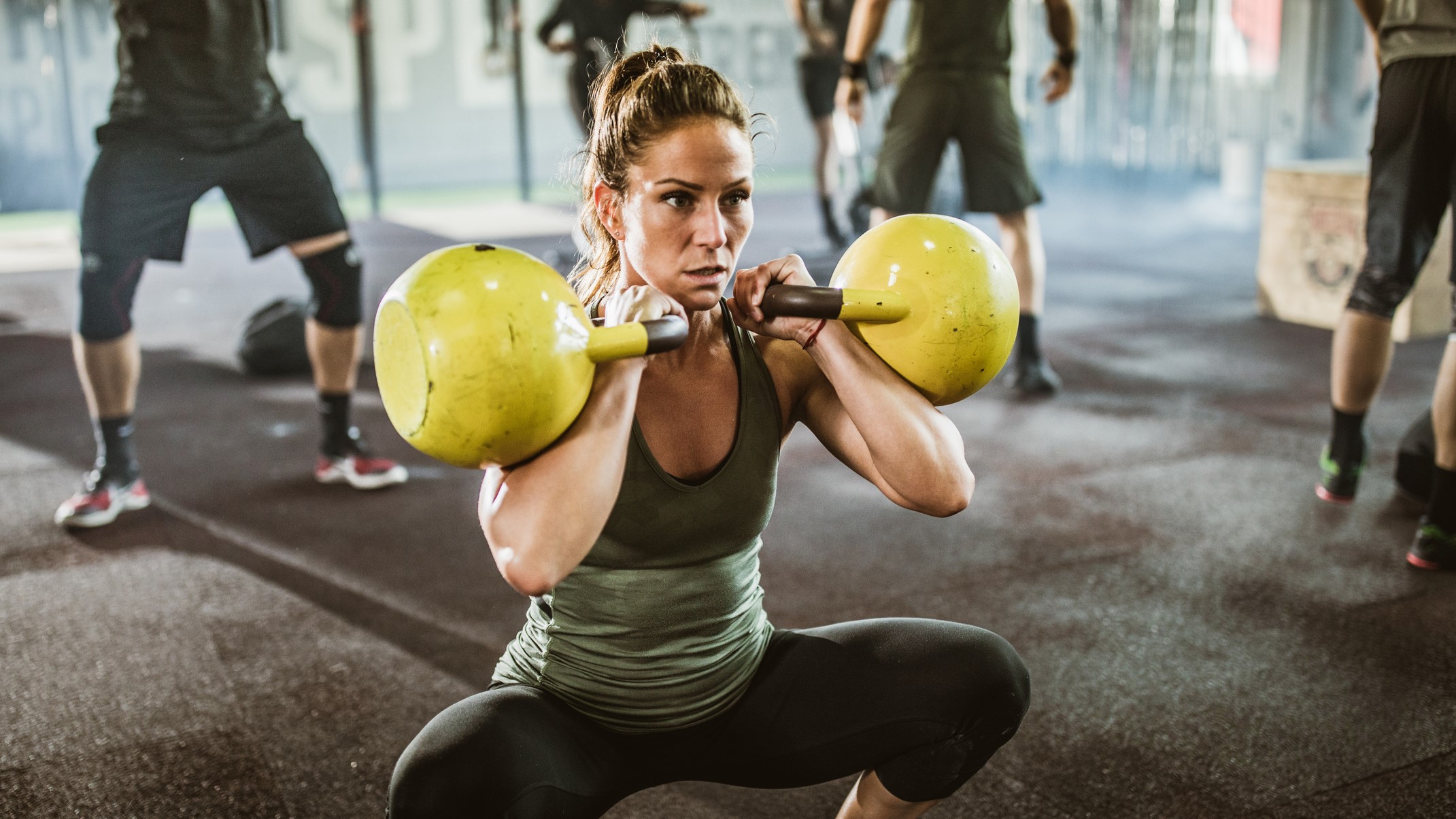
Hands up if your knees start singing out during lunges? If you’re nodding along, forget lunges (just for now) because you won’t need them during this 3-move kettlebell leg workout.
Lunges are part of the best strength programs for a reason — the exercise strengthens the hips, glutes, quads, hamstrings and calves, torches your lower body muscles, and you can load them endless ways — front lunges, reverse, curtsy, Bulgarian split squats — you name it, there’s a lunge for it.
But if your knees are saying no, this three-move leg workout sculpts your lower body using two of the best kettlebells or a set of dumbbells. No gym machines or lengthy strength programs to contend with. Just you, your body weight and two medium-heavy weights.

These three knee-friendly leg exercises tick boxes for functional training and compound movement. If you’re unfamiliar with both terms, the moves recruit various joints and muscle groups in a single effort (you get more for less!) and closely resemble the activities you do throughout the day — picking shopping bags up from the floor or standing up, for example.
Forget lunges — what is the 3-move kettlebell leg workout?
We love training with kettlebells at Tom’s Guide, and there are mountains of research singing the praises of the small but mighty bells. Kettlebell training helps develop explosive strength and muscular endurance and build muscle, and learning how to hold a kettlebell properly opens up a world of possibilities when programming leg exercises for your workouts.
Unconvinced? Here are the 7 best kettlebell ab exercises and a 4-move single kettlebell workout to torch your whole body in 20 minutes for inspiration.
Now, on to the workout.
Get instant access to breaking news, the hottest reviews, great deals and helpful tips.
EMOM 15
Perform the exercises below as an EMOM — every minute on the minute. Aim for 8-15 reps per move, depending on your strength and experience. Lift heavy, complete the reps and rest for the remainder of the minute.
If you finish before 45 seconds, add reps. And if you can’t complete them before 60 seconds, reduce them. Aim for 10-15 seconds rest each time, then start the next exercise on the next minute. Go for 5 rounds, totaling 15 minutes.
1. Kettlebell suitcase deadlift
Place a kettlebell on either side of your feet close to your legs and stand with feet hip-width apart. Perform a deadlift by driving your hips back, bending your knees and hinging forward to grip a kettlebell in each hand. Keep your core engaged, back flat and pull your shoulders back and down. Set your back, squeeze your lats and drive through both feet to stand up with the bells. Slowly lower back down to place the kettlebells on the ground.
We dissect how to deadlift with perfect form here so you can execute the move properly.
2. Kettlebell front rack step-ups
You could use a bench, step or stairs for this move. Rack both kettlebells onto your shoulders with elbows slightly lifted and your abs engaged. Stand tall through your spine, then step one foot onto the bench and plant the heel firmly down.
Push through the same foot and drive upward to stand on the bench and squeeze your glutes. Then lower your other foot down hip-width apart. Step back down with the opposite foot first, and remember to alternate as you move. Here's what happened when our writer did 80 dumbbell step ups every day for a week.
3. Kettlebell thrusters
Rack your kettlebells onto your shoulders and slightly lift your elbows. Adopt a double kettlebell front squat stance and position feet hip-width or shoulder-width apart. Engage your core and keep your chest proud, then bend your knees and lower into the squat position with a flat back. Pause at the bottom of the squat with thighs parallel to the floor, then drive up through your feet and extend the bells above your head into an overhead press position.
Bottom line
Aim to move with explosive power and control throughout each leg exercise, keeping your stomach braced and spine neutral as you move. Some studies have shown that unilateral exercises teach both sides of the body to recruit together; practicing unilateral movement helps improve balance, coordination, stability and power.
Unlike training with barbells, there’s nowhere for your weaker muscles to hide during single-sided exercises, meaning your dominant side can’t pick up the slack from your weaker muscles. All three leg exercises force your muscles to work as a unit this way, but you’ll be thankful for a more robust body.
Aim to lift heavy weights and use your hip flexors, core and glutes — stabilizing muscle groups — to drive movement. The workout is pretty quad and glute-dominant, but your hamstrings still work during each exercise and shine during deadlifts.
Be brave enough to enter the pain cave by achieving enough weight and reps that your legs reach fatigue without burning them out too early.
More from Tom's Guide
- Swimming vs running: Which burns more calories?
- This is Ryan Reynold's arm workout for Deadpool 3
- This kettlebell workout takes only 15 minutes to torch your whole body.

Sam Hopes is a level 3 qualified trainer, a level 2 Reiki practitioner and fitness editor at Tom's Guide. She is also currently undertaking her Yoga For Athletes training course.
Sam has written for various fitness brands and websites over the years and has experience across brands at Future, such as Live Science, Fit&Well, Coach, and T3.
Having coached at fitness studios like F45 and Virgin Active and personal trained, Sam now primarily teaches outdoor bootcamps, bodyweight, calisthenics and kettlebells.
She also coaches mobility and flexibility classes several times a week and believes that true strength comes from a holistic approach to training your body.
Sam has completed two mixed doubles Hyrox competitions in London and the Netherlands and finished her first doubles attempt in 1:11.


